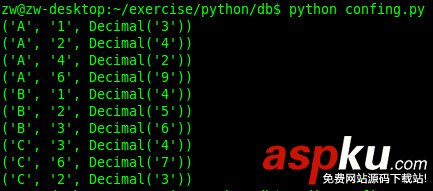python文件读写
python 进行文件读写的内建函数是open或file
file_hander(文件句柄或者叫做对象)= open(filename,mode)
mode:
模式 说明
r 只读
r+ 读写
w 写入,先删除源文件,在重新写入,如果文件没有则创建
w+ 读写,先删除源文件,在重新写入,如果文件没有则创建(可以写入写出)
读文件:
>>> fo = open("/root/a.txt")>>> fo <open file '/root/a.txt', mode 'r' at 0x7f5095dec4e0>
'hello davehe/ni am emily/nemily emily/n'
>>> fo.close()>>> fo.read() #对象已关闭,在读取就读不到
Traceback (most recent call last): File "<stdin>", line 1, in <module>ValueError: I/O operation on closed file
>>> f1 = file("/root/a.txt") >>> f1.read() 'hello davehe/ni am emily/nemily emily/n'
写文件:
root@10.1.6.200:~# ls -l new.txt
ls: cannot access new.txt: No such file or directory
>>> fnew = open("/root/new.txt",'w') w参数文件没有则创建>>> fnew.write('hello /n i am dave') 这时查看文件数据其实还只是在缓存区中,没有真正落到文件上.
root@10.1.6.200:~# cat new.txt root@10.1.6.200:~#
只要我把文件关闭,数据会从缓存区写到文件里
>>> fnew.close()root@10.1.6.200:~# cat new.txt
再次使用w参数,文件会被清空,所以用该参数需要谨慎.
>>> fnew = open("/root/new.txt","w") root@10.1.6.200:~# cat new.txt root@10.1.6.200:~#
mode使用r+参数:
>>> fnew = open("/root/new.txt",'r+')>>> fnew.read() >>> fnew.write('i am dave')>>> fnew.close() root@10.1.6.200:~# cat new.txt
这次打开文件,直接写入,会发现ooo替换开头字母,因为上面读取操作使用了指针在写就写在后面.而这次是直接从头写入.
>>> fnew = open("/root/new.txt",'r+')>>> fnew.write('ooo')>>> fnew.close() root@10.1.6.200:~# cat new.txt
文件对象方法
下面文件对象方法
- FileObject.close()
- String=FileObject.readline([size])
- List = FileObject.readlines([size])
- String = FileObject.read([size]) read:读取所有数据
- FileObject.next()
- FileObject.write(string)
- FileObject.writelines(List)
- FlieObject.seek(偏移量,选项)
- FlieObject.flush() 提交更新
>>> for i in open("/root/a.txt"): 用open可以返回迭代类型的变量,可以逐行读取数据... print i... hello davehei am emilyemily emily
FileObject.readline: 每次读取文件的一行,size是指每行每次读取size个字节,直到行的末尾,超出范围会读取空字符串
>>> f1 = open("/root/a.txt")>>> f1.readline() >>> f1.readline()''>>> f1.readline()''>>>f1.close()
FileObject.readlines:返回一个列表
>>> f1 = open("/root/a.txt")>>> f1.readlines() ['hello davehe/n', 'i am emily/n', 'emily emily/n']''
FileObject.next:返回当前行,并将文件指针到下一行,超出范围会给予警示,停止迭代.
>>> f1 = open("/root/a.txt")>>> f1.next() Traceback (most recent call last): File "<stdin>", line 1, in <module>StopIteration
FileObject.write:write和后面writelines在写入前会是否清除文件中原来所有的数据,在重新写入新的内容,取决于打开文件的模式.
FileObject.writelines(List):多行写,效率比write高,速度更快,少量写入可以使用write
>>> l = ["python/n","python/n","python/n"]>>> f1 = open('/root/a.txt','a')>>> f1.writelines(l)>>> f1.close() root@10.1.6.200:~# cat a.txt
hello davehei am emilyemily emilypythonpythonpython
FlieObject.seek(偏移量,选项):可以在文件中移动文件指针到不同的位置.
位置的默认值为0,代表从文件开头算起(即绝对偏移量),1代表从当前位置算起,2代表从文件末尾算起.
>>> f1 = open('/root/a.txt','r+')>>> f1.read() 'hello davehe/ni am emily/nemily emily/npython/npython/npython/n'
>>> f1.seek(0,0) 指针指到开头,在读>>> f1.read()
'hello davehe/ni am emily/nemily emily/npython/npython/npython/n'
>>> f1.read()''>>> f1.seek(0,0)>>> f1.seek(0,2) 指针指到末尾,在读>>> f1.read()''
下面看个小实例,查找a.txt中emily出现几次
root@10.1.6.200:~# vim file.py
#!/usr/bin/env pythonimport ref1 = open('/root/a.txt')count = 0for s in f1.readlines(): li = re.findall("emily",s) if len(li) > 0: count = count + len(li)print "this is have %d emily" % count f1.close() root@10.1.6.200:~# cat a.txt
hello davehei am emilyemily emily
root@10.1.6.200:~# python file.py



















